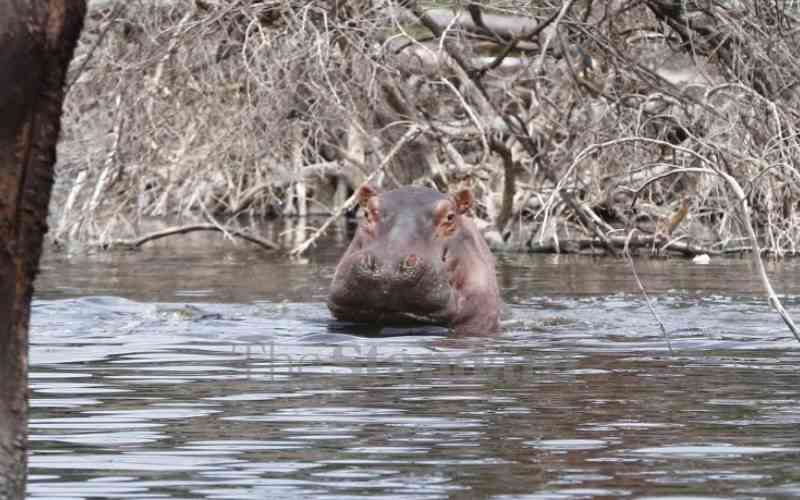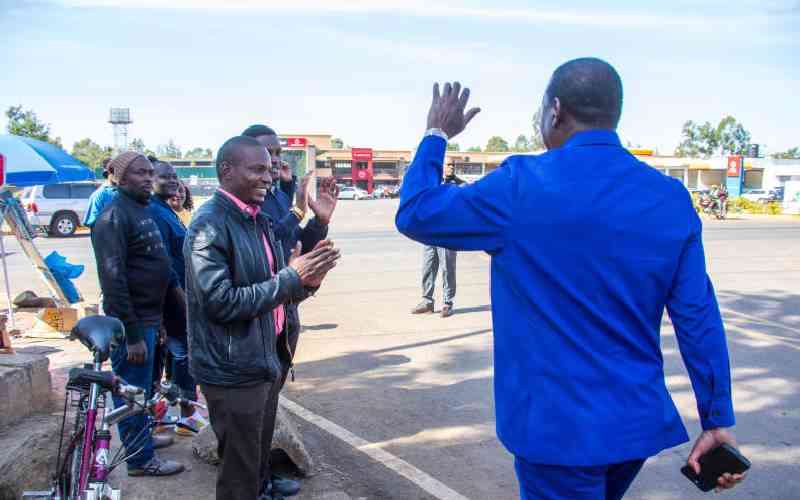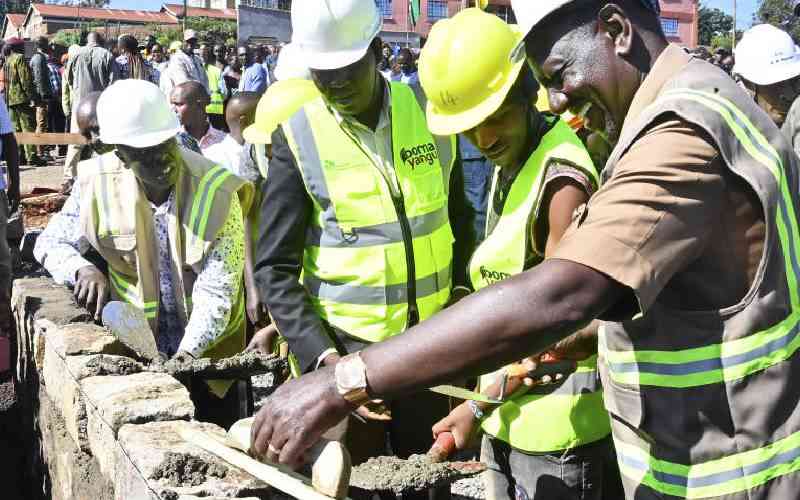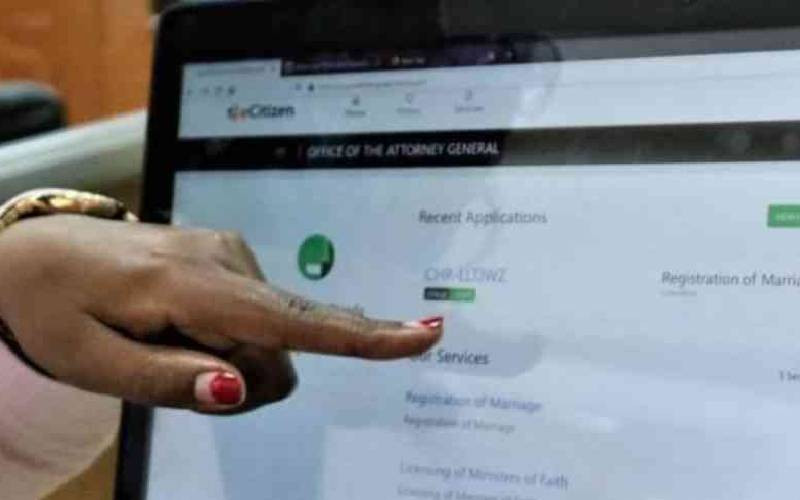 |
|
DPM Uhuru Kenyatta and former Head of Civil Service, Francis Muthaura at The ICC during the confirmation of charges, in 2012. [Photo: File/Standard]
|
By Evelyn Kwamboka
KENYA: The ICC Prosecutor now says she has additional incriminating evidence sufficient to sustain murder charges against Mr Uhuru Kenyatta, Mr William Ruto and two other Kenyan suspects.
The enhanced murder charges were contained in updated documents of charges prepared by Gambia-born Fatou Bensouda on the serious crimes against humanity facing the four Kenyans.
The new document reasserts alleged meetings held at State House, Nairobi, with Uhuru playing the central role in planning the revenge attacks witnessed in Naivasha.
As for Ruto who the prosecutor saddles with the Kiambaa church killings in Eldoret, the Prosecutor introduces a new list of alleged accomplices he was supposed to have worked with in mobilising, coordinating and commanding the killings in the Rift Valley.
Key among the names is that of Industrialisation minister and Tinderet MP Henry Kosgey, who initially the prosecution sought to have indicted alongside the four, before he was let off for lack of evidence that the judges felt would sustain trial.
Also listed as Ruto’s accomplices, though not for purposes of being charged by to show the depth of alleged planning and execution of a ‘common plan’ with military precision, are four senior former security officials from the Rift Valley.
They are two former military generals, John Koech and Augustine Cheruiyot, as well as former GSU and presidential service Commandant Samson Cherambos, who incidentally was one of the witnesses Ruto took to The Hague during pre-trial stage in a bid to clear his own name.
Also mentioned along this line is former international athlete killed in the clashes, Lucas Sang, as well as Mount Elgon MP Fred Kapondi.
Also listed as an accomplice is a renowned businessman and big-time farmer in Eldoret, Mr Jackson Kibor, a former ally of Ruto who was at first charged in a Kenyan court with the violence, but the charges were later dropped.
In her documents Bensouda outlined the kind of weaponry, strategies adopted to corner the targets of violence, the locations of attacks, and the manner in which the victims were executed as well as how the assaults were carried out and communication among perpetrators conveyed, to anchor the enhanced count she wants them charged with.
The evidence supporting murder charges during the 2007-2008 post-election violence, she made clear; also apply for the counts facing former Head of Civil Service Francis Muthaura, who is charged alongside Uhuru, and Kass FM’s head of operations Mr Joshua Arap Sang, who shares his charges with Ruto.
It now means that Uhuru, who is the Jubilee alliance presidential candidate, and Ruto who is his running mate, will have to put up a bigger fight to extricate themselves from the cases that will start shortly after the March 4 elections, and on the day of a runoff if there will be one.
The additional evidence against Uhuru, who like the other three suspects, has denied he played a role in mobilising arming, coordinating and paying the two sets of attackers, is linked to six specific murders in which guns were used in Naivasha.
Stay informed. Subscribe to our newsletter
Ruto is also alleged to have been behind the murder at Nandi Hills where three people were killed as a result of petrol bombs. The attackers in Nandi Hills also allegedly used bows and arrows during the election violence according to the new evidence.
Bensouda says the additional evidence will convince the Pre-Trial Chamber to confirm the murder charges touching on those two areas.
“The prosecution respectfully informs the Chamber that since the confirmation hearing, the prosecution has obtained additional evidence to substantiate this factual allegation,” she said in her submissions.
Accordingly, the prosecution intends to apply to the Pre-Trial Chamber to include the allegation touching on the murders to the court.
The new evidence on the Naivasha killings shows that victims were shot and their bodies mutilated to conceal gunshot wounds.
If the Pre-Trial Chamber judges confirm the alleged claims, the prosecution will have no option but to seek the Trial Chamber’s permission to re-insert that charge.
Bensouda said the application was aimed at properly putting the defence team on notice. The prosecutor said that in the event she does not seek confirmation of the additional evidence, the prosecution might seek to lead the evidence during trial.
The latest twist comes following the Trial Chamber’s decision to order the prosecution to remove the claims on six victims who were allegedly killed by gunshot wounds from the murder charge against Uhuru and Muthaura.
The evidence was also expunged over the three murders allegedly committed through Ruto and Sang’s support in Nandi Hills town-ship.
Bensouda argues that Uhuru and Muthaura committed murder and forcibly transferred the population by allegedly adopting the common plan to commit widespread and systematic attacks in retaliation against perceived Orange Democratic Movement supporters in Naivasha and Nakuru.
They are also alleged to have established links with the outlawed Mungiki sect and secured support and services for President Kibaki’s Party of National Unity and making use of existing outlawed Mungiki sect structures by establishing a localised level of subordinates among PNU politicians.
The document filed at the ICC court on January 5 further indicates that this allowed them maximum control over the attacks.
“Kenyatta and Muthaura participated in multiple meetings at State House in Nairobi on December 30, 2007 and about January 3, 2008 at the Nairobi Club,” says the updated document.
The meetings were allegedly held to activate the Mungiki and pro-PNU youths by placing the organisation under their central authority and to implement a common plan.
Uhuru and Muthaura allegedly committed the crimes against humanity by soliciting the support and contribution of local politicians and businessmen, providing funds and weapons to direct perpetrators.
Lawyers defending Muthaura countered allegations that he instructed the police not to interfere with attacks in Rift valley.
The prosecution claims Mungiki and PNU youth were deployed in various parts of Nakuru where targeted communities were attacked using petrol bombs, knives, machetes and guns.
The prosecution claims in the document that the attackers shot their victims between January 24 and 27, 2008 and mutilated their bodies to conceal gunshot wounds in areas such as Kaptembwa, Sewege, Ponda Mali, Barut and Kapkures.
“From on or about January 27 to 28, 2008, Muthaura and Kenyatta committed, jointly with each other and through members of the Mungiki group and pro-PNU youth, crime against humanity of the murder of civilians perceived to be supporters of ODM,” Bensouda stated.
Within that period, the prosecution said at least 23 victims were killed, including 13 children, in Naivasha.
It was in Nakuru that Mungiki and pro-PNU youth went from house to house rounding up and forcibly circumcising men from one community using pangas and broken bottles.
“Six people were treated at the Provincial General Hospital of Nakuru for traumatic circumcision,” charges Bensouda.
According to the prosecution, Rift Valley suffered the biggest brunt of the violence with 700 deaths and 400,000 forcible transfers of the population recorded.
Ruto and Sang’s defence counsel are to grapple with claims that between 2006 to January 2008, their clients, along with others, planned to forcibly evict from the province members of three communities that were perceived to be PNU supporters.
This they were to allegedly do in a bid to have the region vote as a bloc in future general elections.
“Ruto and Sang knew that their conduct was part of, or intended for their conduct to be part of, a widespread or systematic attack,” she charges.
“Perpetrators armed with arrows and machetes attacked Langas on January 1, 2008,” she stated.
 The Standard Group Plc is a
multi-media organization with investments in media platforms spanning newspaper
print operations, television, radio broadcasting, digital and online services. The
Standard Group is recognized as a leading multi-media house in Kenya with a key
influence in matters of national and international interest.
The Standard Group Plc is a
multi-media organization with investments in media platforms spanning newspaper
print operations, television, radio broadcasting, digital and online services. The
Standard Group is recognized as a leading multi-media house in Kenya with a key
influence in matters of national and international interest.
 The Standard Group Plc is a
multi-media organization with investments in media platforms spanning newspaper
print operations, television, radio broadcasting, digital and online services. The
Standard Group is recognized as a leading multi-media house in Kenya with a key
influence in matters of national and international interest.
The Standard Group Plc is a
multi-media organization with investments in media platforms spanning newspaper
print operations, television, radio broadcasting, digital and online services. The
Standard Group is recognized as a leading multi-media house in Kenya with a key
influence in matters of national and international interest.









